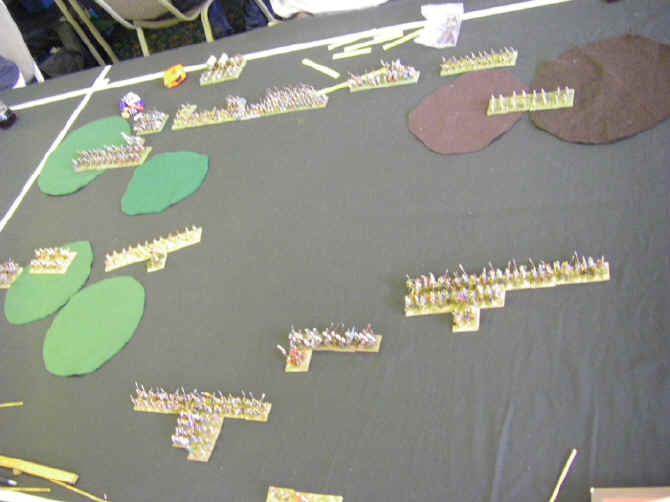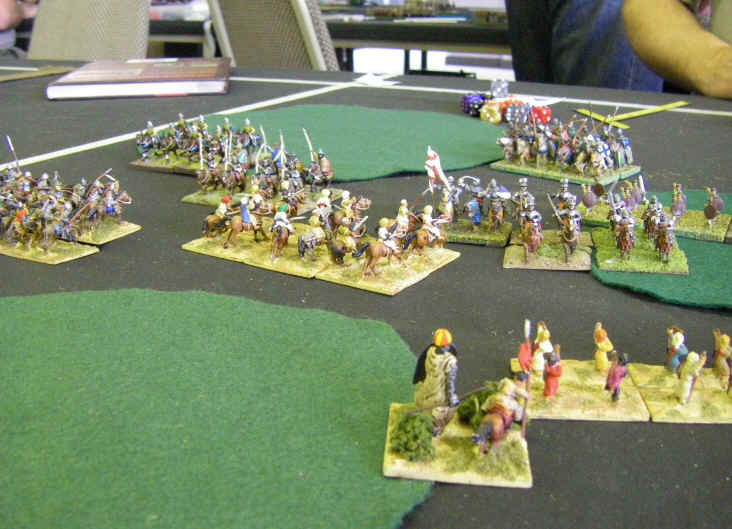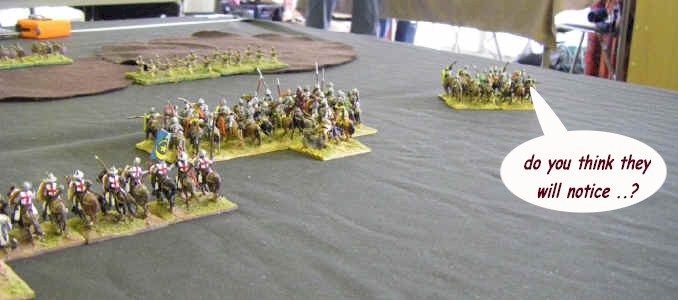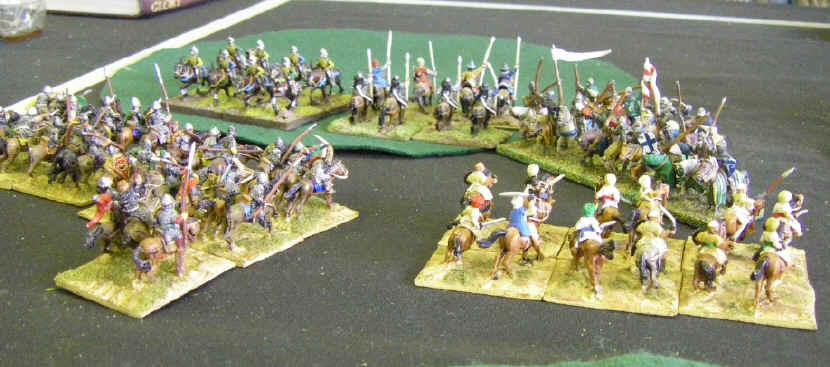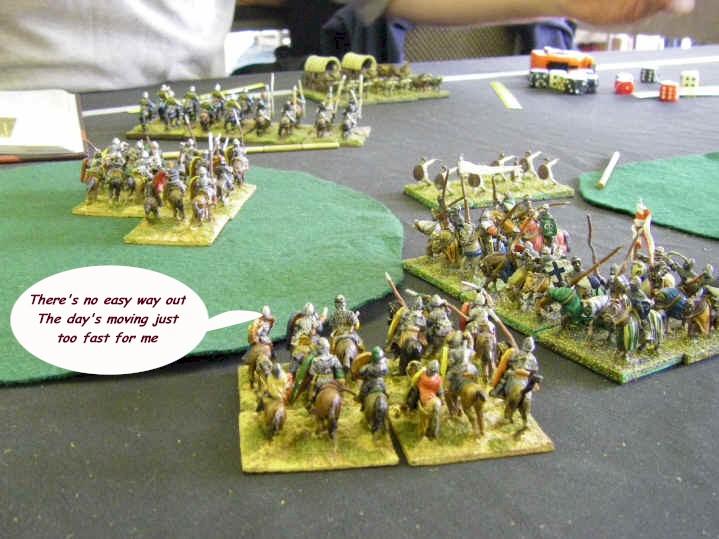Game 2 of FoG at Britcon 2008
After a confident start on Friday night I found myself fairly high up the table and facing a textbook heavy medieval army - Crown of Aragon
This time the terrain fell terribly for me, with a good 1/3 of the table covered in open fields, handily arranged in an Almughavar Motorway and two other terrain pieces securing the Aragonese' other flank. Open Fields are a form of magic terrain. You get some compulsary in some terrain types, they don't delay light horse or MF, but they negate lancer PoAs and the mounted vs MF PoAs as well at impact.
Expecting the Aragonese to regard the field-covered flank as pretty secure, I attempted to force my way through it in a 1939 Maginot line outflanking through the Ardennes manner.
This brought into play for the first time my secret weapon - lancer swordsman armed light horse!! But it also brought into play the Spaniards not quite so secret weapon - some drilled knights. Drilled troops led by a general are highly unlikely to charge without orders. They pass on a 5 or more.
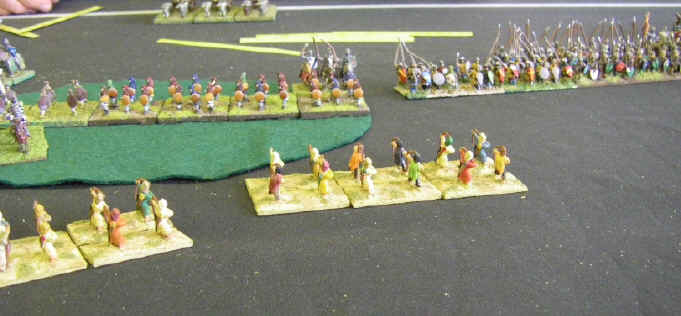
I had also left my few psiloi with quite a lot to do, in occupying the heavy foot of the Aragonese and teasing them into a rash advance
The rest of my mounted punch was waiting for the Aragonese to expose their flank as they hopefully advanced rashly past the protective difficult terrain, and one unit even thought about sneaking round the flank to loot the baggage....
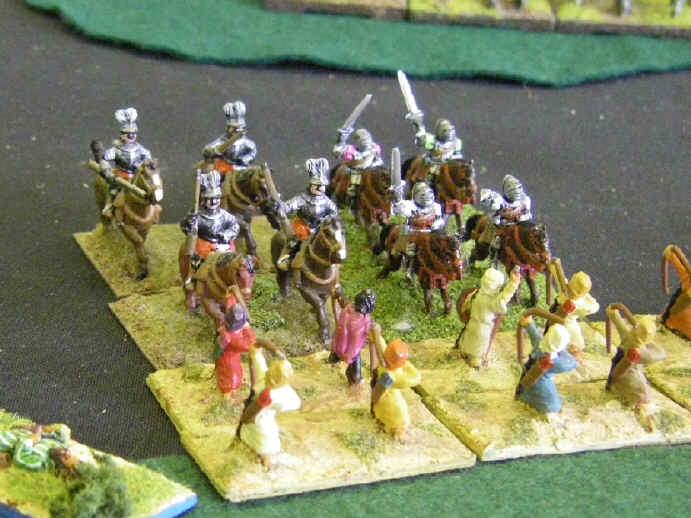
But as we messed around trying to weave all of these various different strands of strategy into a tapestry of success the Aragonese adopted route 1 and charged into some of my light infantry !! Light foot will be caught and butchered surprisingly often by LF - the LF go 2 inches faster anyway, and you can have up to a 4 inch swing in + and - evade rolls.
The dastardly Spaniards were also refusing to play ball on the left as well, as their surprisingly maneuverable knights refused point blank to charge anything of mine that might possibly evade and ambled towards my own lancers... Drilled troops - sheesh!! Even knights can do what they like...
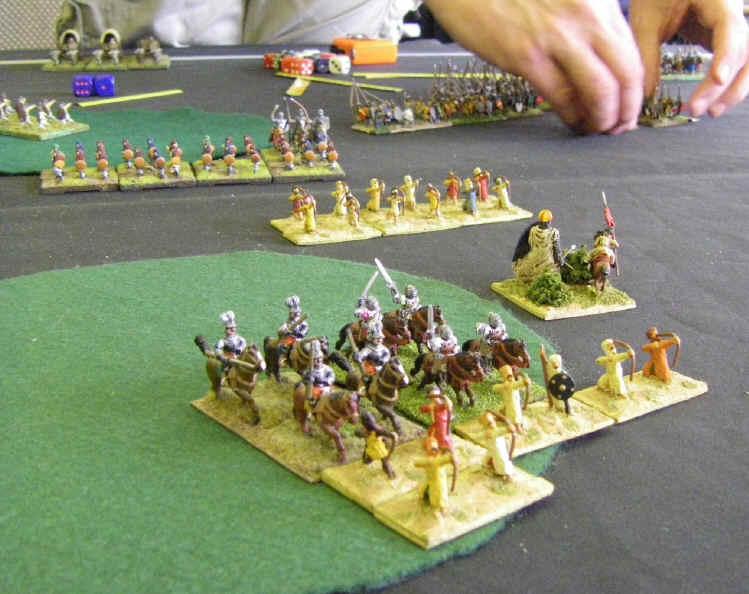
Soon my psiloi were in full retreat and the FC decided to leave them to die and saunter off elsewhere...As they took his soul they stole his pride...
The knights continued their deliberate ballet, and one unit of my lancers took the opportunity to waste itself futilely trying to catch light horse - a total impossibility in the terrain which slowed us but not them. However my other lancers were by now pinned down and set to die... Ideally I'd have done a 90 degree turn and simply walked away to buy one or two turns grace here, but I failed the CMT. Again, if I was drilled....
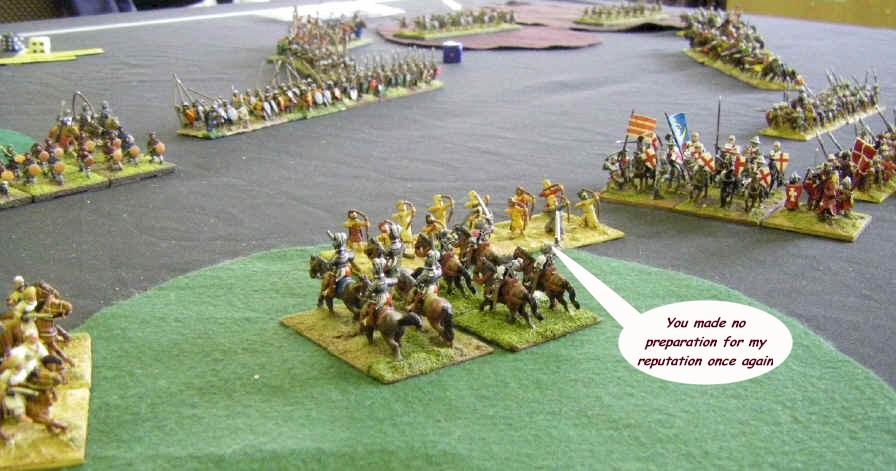
The Aragonese light horse, having digested one set of psiloi, decided it was time to sneak in another as they returned to the main stage once more - but a threatening approach from my own lance armed light horse soon made them think again. Setting up a potential flank charge is very useful. However my lancers ended up pursuing the Aragonese light horse for the rest of the game, eventually into my own baggage which I then lost. With both units moving exactly the same speed at all times, it's almost impossible for one light horse unit to chase down another - they can always wriggle out of trouble, and charging them only seems to serve to give them a free move (they move in your turn as well as their own). It appears that you need 2 units to be able to trap and catch one LH unit !
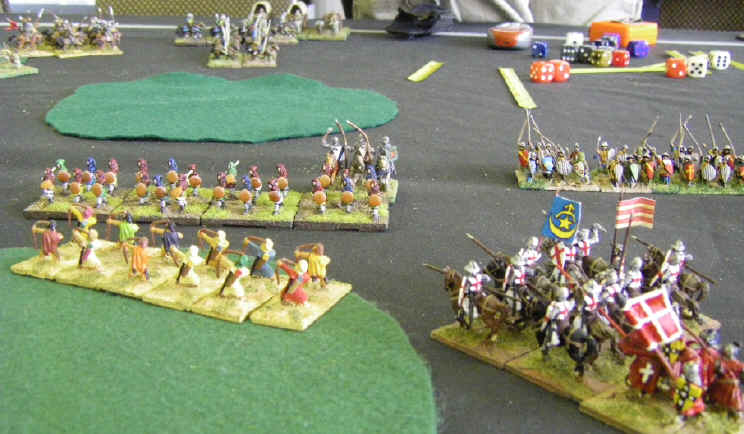
Soon the advancing Crusaders were teeing themselves up for a brilliant interception charge against the Almughavars, who surely must charge my archers?
But NO!!! In another rule written to irritate me alone, apparently medium foot who might be intercepted by mounted in the open don't need to test not to charge !! FoG Rule no 7 - if the situation can go against Tim, it does
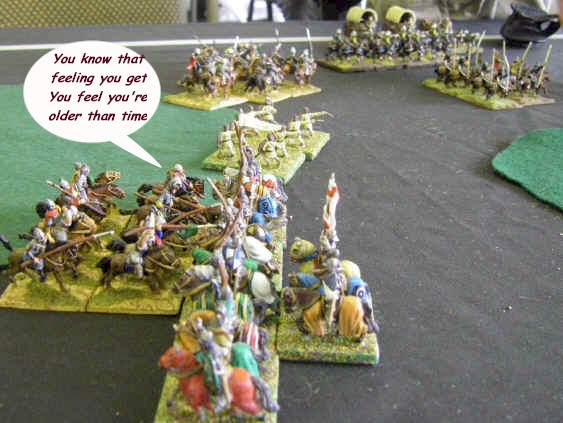
My lancers were by now fighting - and had somehow ended up conforming into the dreaded open field ! (nope, not sure how either..)
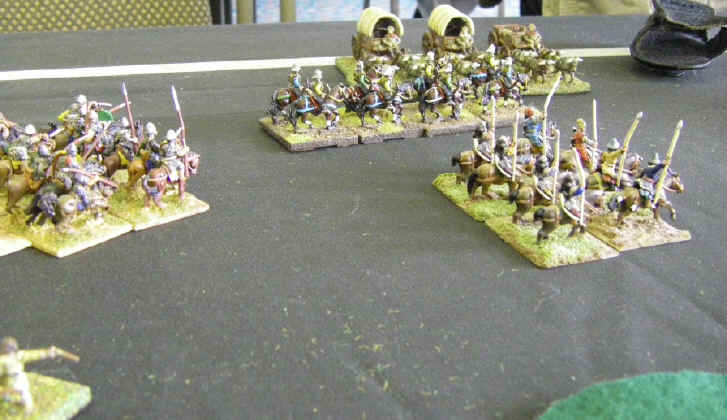
At least I was getting close to the baggage even if I wasn't able to catch the light horse...
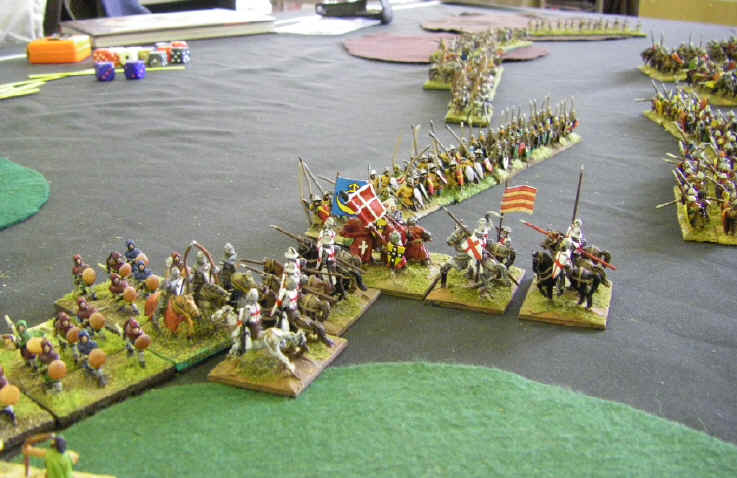
And my knights had charged into both the Almughavars and a unit of Spearmen - in a strange form of contact that reduced overlaps on me - at last something was working !! Only having 1 base in the field was pretty cool for me, as disorder loses one dice in 3, and so with only 2 dice in the field I suffered no ill effects. I also did not confirm at all in this combat as it was impossible for me to do so, so the melsee was fought in this offset formation until the next turn
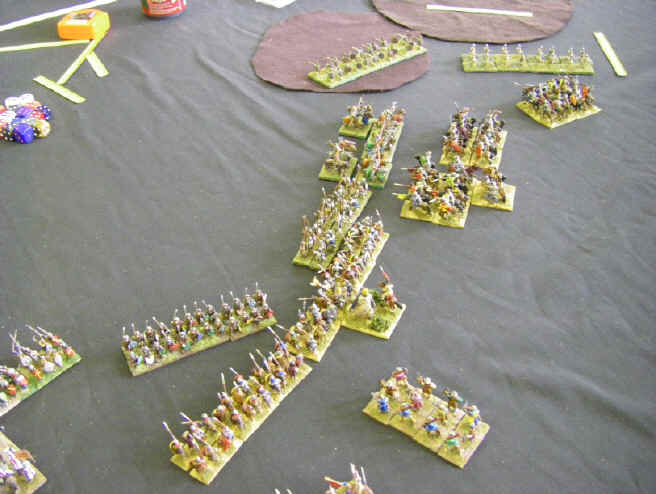
My battle plan was at last starting to look as if it had half worked, with my cavalry ganging up on a unit of knights on the far right, and a reasonably advantageous spear fight shaping up in the middle.
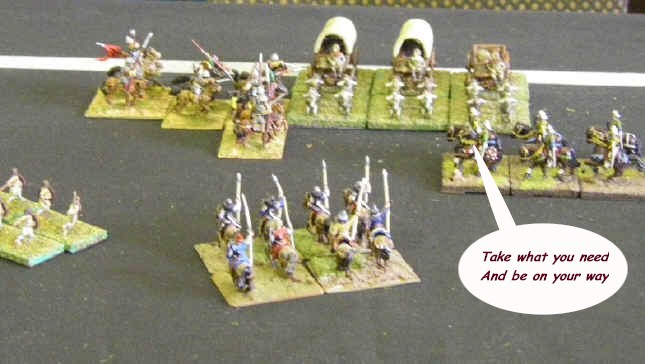
My troops had even managed to overrun the enemy baggage camp, although quite what they would do next was beyond me ...
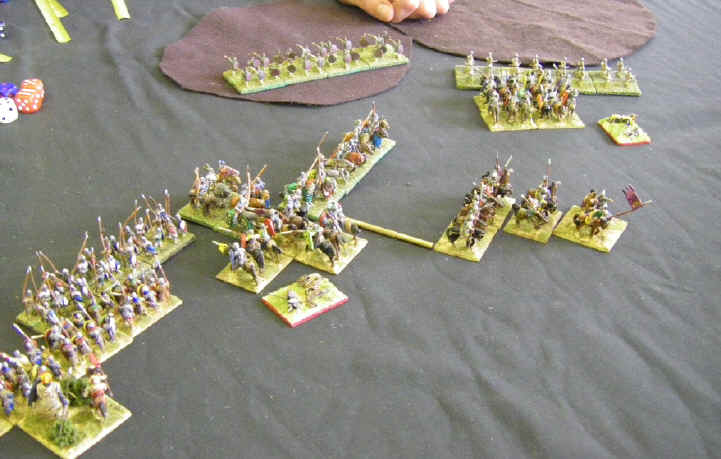
However, no matter how well my plan looked to be being implemented, "contact with the enemy" was proving problematic and things started to go wrong quite quickly as my armoured lancers imploded against the heavily armoured knights, sending ripples of despair along my lines as my spearmen continued to engage in a standoff with neither side wishing to charge home. (defensive spears being useless at impact if they charge..)
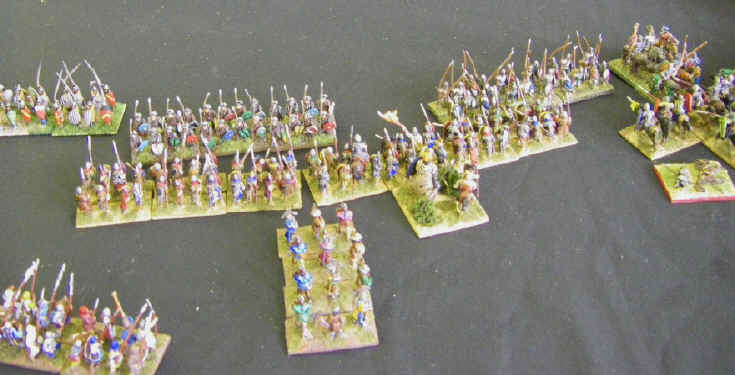
With my army unable to survive the loss of virtually all of its main strike force of cavalry and knights and baggage, my army imploded and I fell to a total defeat !
Post match Analysis
Horrific terrain for me provided a massive benefit to the Spaniards, protecting both flanks and allowing their light horse, almughavars and bowmen to operate with total impunity against my slowed down and toothless (lance-PoA-removed) mounted force - in every occasion I found myself there had seemed to be a rule written specifically to disadvantage me ! Open fields are quite something ....
Knights also proved to be wildly better than cavalry lancers who failed to stand up to any sort of questioning, and the drilled knights showed no interest in charging and getting out of position at all.
Want some knights of your own? Click and bid on eBay from here
View My Stats
The Ancient Army List Index
The Rise of Rome (280 BC to 25 BC) Mid Republican Roman ; Late Republican Roman ; Gallic ; Pyrrhic ; Later Carthaginian ; Ancient Spanish ; Later Macedonian ; Later Seleucid ; Later Ptolemaic ; Attalid Pergamene ; Numidian or early Moorish ; Pontic ; Early Armenian ; Parthian ; Later Jewish ; Illyrian ; Spartacus Slave Revolt ; Bosporan ;
Storm of Arrows - Western Europe in the Later Middle Ages (1300 AD to 1500 AD) Medieval French ; 100-yrs War English (Continental) ; 100-yrs War English (Britain) ; Later Medieval Scots ( Britain) ; Later Medieval Scots (Continental) ; Later Scots Isles & Highlands ; Medieval Welsh ; Later Anglo-Irish ; Medieval Irish ; Low Countries ; Later Medieval German ; Italian Condotta ; Swiss ; Free Company ; Medieval Burgundian ; Medieval Danish ; Medieval Swedish ; Medieval Castilian ; Medieval Crown of Aragon ; Medieval Portugese ; Later Granadine ; Navarrese ; Ordonnance French ; Wars of the Roses English ; Ordonnance Burgundian ; Santa Hermandad Nueva Castilian
Immortal Fire - The Greek, Persian & Macedonian Wars (550 BC - 146 BC)
Classical Greek ;
Early Achaemenid Persian ;
Lydian ;
Thracian ;
Syracusan ;
Early Carthaginian ;
Skythian or Saka ;
Kyrenean Greek ;
Late Dynastic Egyptian ;
Alexandrian Macedonian ;
Later Achaemenid Persian ;
Classical Indian ;
Early Successor ;
Early Sarmatian ;
Galatian ;
Hellenistic Greek ;
Graeco-Bactrian ;
Graeco-Indian ;
Indo-Greek :
Legions Triumphant - Imperial Rome (25 BC to 493 AD) Dominate Roman ; Principate Roman ; Foederate Roman ; Later Sarmatian ; Early German ; Dacian or Carpi ; Ancient British ; Caledonian ; Early Alan ; Jewish Revolt ; Sassanid Persian ; Kushan or Indo-Skythian ; Palmyran ; Early Frankish, Alamanni, Burgundi, Limigantes, Rugian, Suevi or Turcilingi ; Western Hunnic ; Early Visigothic & Early Vandal ; Early Ostrogothic, Herul, Sciri or Taifali ; Early Anglo-Saxon, Bavarian, Frisian, Old Saxon or Thuringian ; Gepid or Early Lombard ; Early Scots Irish ; Early Pictish ; Hephthalite Hunnic ;
Swords & Scimitars - The Crusades (1096 AD to 1311 AD) Early Crusader ; Later Crusader ; Fatimid Egyptian ; Georgian ; Seljuk Turk ; Cuman ; Komnenan Byzantine ; Post Latin Conquest Byzantine ; Ilkhanid Mongol ; Mamluk Egyptian ; Cilician Armenian ; Syrian States ; Khwarazmian ; Ayyubid Egyptian ; Middle Serbian ; Middle Bulgarian ; Medieval Cypriot ; Latin Greece ; Pecheneg ;
Eternal Empire - Eastern Europe and the Rise of the Ottomans (1300 AD to 1500 AD) Early Ottoman Turkish ; Later Ottoman Turkish ; Tatar ; Later Russian ; Later Serbian Empire ; Later Bulgarian ; Later Lithuanian ; Later Polish ; Later Teutonic Knights ; Catalan Company ; Middle Hungarian ; Moldavian or Wallachian ; Albanian ; Timurid, White Sheep Turcoman or Black Sheep Turcoman ; Later Hungarian ; Hussite ;
Decline & Fall - Byzantium and Islam (493 AD to 1071 AD) Early Byzantine; Maurikian Byzantine ; Thematic Byzantine ; Nikephorian Byzantine ; Later Moorish ; Later Visigothic ; African Vandal ; Italian Ostrogothic ; Early South Slav ; Lombard ; Avar ; Arab Conquest ; Early Bulgar ; Ummayad Arab ; Abbasid Arab ; Early North African Dynasties ; Khurasanian Dynasties ; Bedouin Dynasties ; Dailami Dynasties ; Pecheneg ; Ghaznavid ; Western Turkish (includes Khazar);
Wolves From The Sea - The Hairy European Dark Ages Post Roman British ; Early Welsh ; Later Scots Irish ; Merovingian Frankish ; Later Pictish ; Early Slavic ; Middle Anglo Saxon ; Astur Leonese ; Andalusian ; Early Navarrese ; Carolingian Frankish ; Viking ; Magyar ; Great Moravian ; Early Scots ; Rus ; Norse Irish ; Early Medieval French ; Early Medieval German ; Norman ; Early Polish ; Anglo Danish ;
Swifter Than Eagles - The Biblical Book Nubian ; Early Libyan ; Later Sumerian or Akkadian ; Early Nomad Allies ; Old or Middle Kingdom Egyptian ; Hyksos ; Mitanni ; Syro-Canaanite ; New Kingdom Egyptian ; Later Minoan or Early Mycenaean ; Hittite Empire ; ; Middle or Early Neo-Assyrian ; Later Mycenaean or Trojan ; Sea Peoples ; Philistine ; Phoenician Allies ; Neo-Hittite And Aramaean ; Later Hebrew ; Mannaean Allies ; Libyan Egyptian ; Urartian ; Median ; Neo-Elamite ; Proto-Arab Allies ; Cimmerian or Early Skythian ; Neo-Assyrian Empire ; Phrygian Allies ; Kushite Egyptian ; Neo-Babylonian Empire ;
Oaf of Fealty - Early Medieval Europe Feudal Catalan and Early Crown Of Aragon ; Early Hungarian ; Taifa Andalusian ; Feudal Navarrese and Aragonese ; Feudal Castilian Leonese or Portuguese ; Fanatic Berber ; Italo-Norman ; Feudal French ; Imperial German ; Feudal German ; Communal Italian ; Papal Italian ; Early Scots Isles And Highlands ; Feudal Scots ; Early Russian ; Feudal Polish ; Anglo-Norman ; Later Welsh ; Early Lithuanian or Samogitian ; Wendish Prussian or Estonian ; Early Medieval Frisia and Other Free Cantons ; Post-Viking Scandinavian ; Early Plantagenet English ; Later Sicilian ; Early Medieval Irish ; Early Anglo-Irish ; Early Teutonic Knights ; Mongol Invasion ; Early Granadine ; Middle Plantagenet English ;
Empires of The Dragon - China, Korea and Japan Erlitou-Shang Chinese ; Early Northern Barbarian Allies ; Early Zhou Chinese ; Yayoi Japanese ; Early Horse Nomad ; Ko Choson Korean ; Warring States To Western Han Chinese ; Qiang And Di ; Three Kingdoms Korean ; Eastern Han Chinese? ; Three Kingdoms W Jin And S Dynasties Chinese ; Kofun Nara Japanese ; Northern Dynasties Chinese ; Later Hindu North Indian ; Later Hindu South Indian ; Central Asian City States ; Western Wei To Early Tang Chinese ; ; Later Horse Nomad ; Tibetan ; Nepalese Allies ; Parhae Korean ; Late Tang To Five Dynasties Chinese ; Khmer Or Champa ; Thai Allies ; Nanzhao ; Pyu Burmese Allies ; Koryo Korean ; Early Heian Japanese ; Pagan Burmese ; Liao ; Song Chinese ; Xi Xia ; Ghurid Afghan ; Jin ; Late Heian To Muromachi Japanese ; Japanese Warrior Monk Allies ; Mongol Conquest ; Moslem Indian Sultanates ; Medieval Indonesian Or Malay ; Yuan Chinese ; Medieval Burmese ; Ming Chinese ; Yi Korean
Blood and Gold - The Americas Olmec ; Teotihuacan ; West Mexican ; Zapotec or Mixtec ; Toltec ; Chinantec ; Aztec ; Tarascan ; Tlaxcalan Confederacy ; Mayan ; Mochica ; Chanca ; Chimu ; Hatun-Colla ; Canari ; Inca ; Mapuche or Araucanian ; Amazonian Forest Tribes ; Tupi ; Chichimec ; Pueblo Culture ; Mound-Builder Culture ; South-Eastern Woodland Culture ; Timucuan ; Eastern Woodland Culture ; Plains Culture ; Pacific North-West Culture


